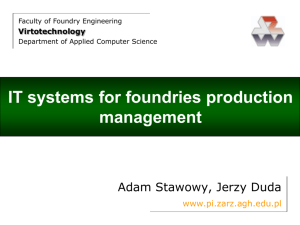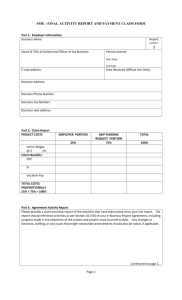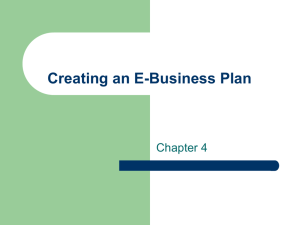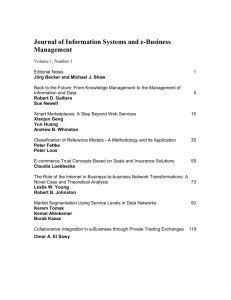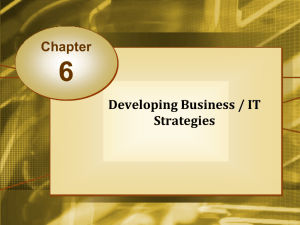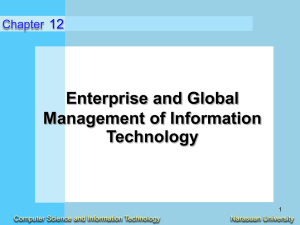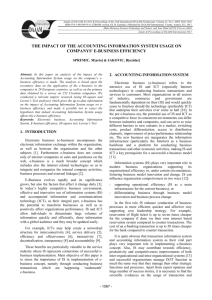Enterprise Resource Planning – the Backbone of E
advertisement
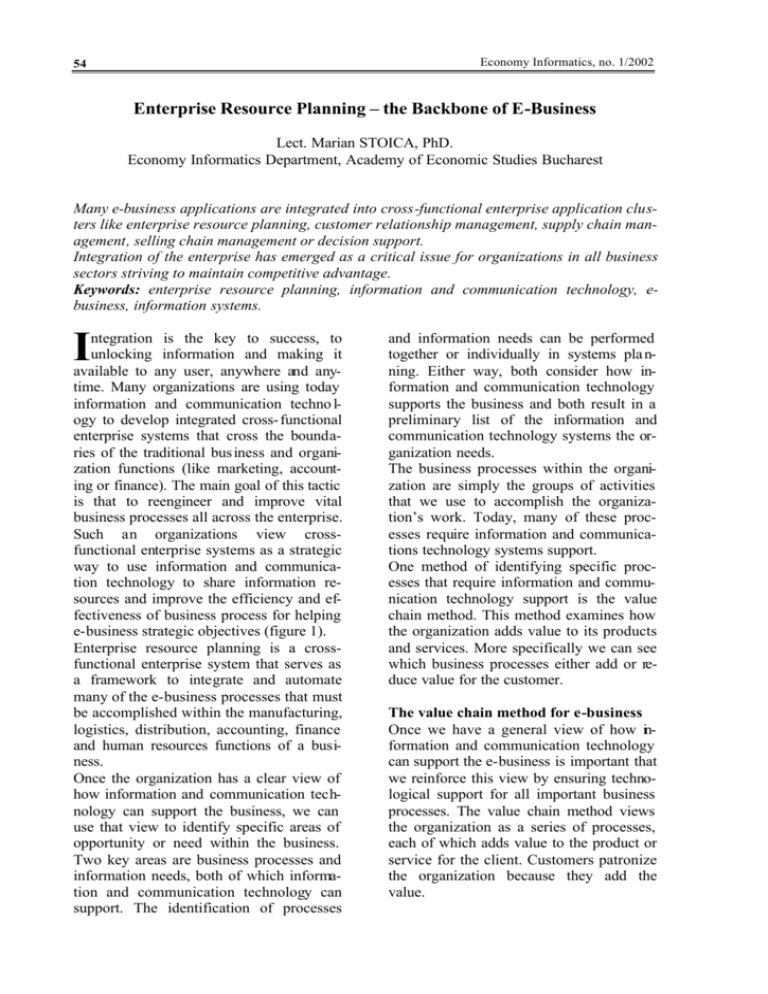
Economy Informatics, no. 1/2002 54 Enterprise Resource Planning – the Backbone of E-Business Lect. Marian STOICA, PhD. Economy Informatics Department, Academy of Economic Studies Bucharest Many e-business applications are integrated into cross-functional enterprise application clusters like enterprise resource planning, customer relationship management, supply chain management, selling chain management or decision support. Integration of the enterprise has emerged as a critical issue for organizations in all business sectors striving to maintain competitive advantage. Keywords: enterprise resource planning, information and communication technology, ebusiness, information systems. I ntegration is the key to success, to unlocking information and making it available to any user, anywhere and anytime. Many organizations are using today information and communication techno logy to develop integrated cross- functional enterprise systems that cross the boundaries of the traditional bus iness and organization functions (like marketing, accounting or finance). The main goal of this tactic is that to reengineer and improve vital business processes all across the enterprise. Such an organizations view crossfunctional enterprise systems as a strategic way to use information and communication technology to share information resources and improve the efficiency and effectiveness of business process for helping e-business strategic objectives (figure 1). Enterprise resource planning is a crossfunctional enterprise system that serves as a framework to integrate and automate many of the e-business processes that must be accomplished within the manufacturing, logistics, distribution, accounting, finance and human resources functions of a business. Once the organization has a clear view of how information and communication technology can support the business, we can use that view to identify specific areas of opportunity or need within the business. Two key areas are business processes and information needs, both of which information and communication technology can support. The identification of processes and information needs can be performed together or individually in systems pla nning. Either way, both consider how information and communication technology supports the business and both result in a preliminary list of the information and communication technology systems the organization needs. The business processes within the organization are simply the groups of activities that we use to accomplish the organization’s work. Today, many of these processes require information and communications technology systems support. One method of identifying specific processes that require information and communication technology support is the value chain method. This method examines how the organization adds value to its products and services. More specifically we can see which business processes either add or reduce value for the customer. The value chain method for e-business Once we have a general view of how information and communication technology can support the e-business is important that we reinforce this view by ensuring technological support for all important business processes. The value chain method views the organization as a series of processes, each of which adds value to the product or service for the client. Customers patronize the organization because they add the value. Economy Informatics, no. 1/2002 55 Customer Feedback Market Research & Tests Product Design Process Design Equipment Design Production Start Fig. 1. The new product development process for e-business If we view the organization as a value chain, we can also identify the important processes in adding value for customers and identify information and communication system that support those processes. Figure 2 depicts the components of value chain. The chain of primary value processes along the bottom half takes the raw materials and makes, delivers, markets and sells and services the organization’s products or services. Processes along the top half of the chain such as management, accounting, finance, legal, human resources, research, deve lopment and purchasing support the primary value processes. The organization requires these support value processes to ensure the smooth operation of the primary value processes. All value chain processes have an individual value. These processes, combined in most organizations have a total value greater than the sum of their ind ividual value. This additional value is called value-added. The value chain is composed of primary value and support value processes. From Economy Informatics, no. 1/2002 56 left to right and along the bottom half of the chain, the organization creates its product or service through primary value processes. Greater value-added means a competitive advantage and greater profits. Support Value Processes Management, Accounting, Finance, Legal Human Resource Management Research and Development ValueAdded Primary Value Processes Acquisitions Receive and store raw materials Deliver the product or service Make the product or service Service after the sale Market and sell the product/service Fig. 2. The components of a value chain in organization In this context, many organizations began installing enterprise resource planning systems as a vital conceptual foundation for reengineering their business processes and as the software engine required to accomplish these new cross- functional processes. “Now the enterprise resource planning is being recognized as a necessary ingredient for the efficiency, agility and responsiveness to customers and suppliers that an ebusiness enterprise needs to succeed in the dynamic world of information society.” [O’Brien] References Daft R.L., Organisation Theory and Design (4th ed.), West Publishing Company, St. Paul 1992 Dertouzos M.L., What will be; How the New World of Information Will Change Our Lives, USA 1997, © Ed. Tehnica, Bucuresti 2000 Ducheyne D., The Information Society, in Gent Works, nr. 107, iunie 1996 eEurope – An Information Society for All, Progress Report, For the Special European Council on Employment, Economic reforms and Social Cohesion Economy Informatics, no. 1/2002 – Towards a Europe based on Innovation and Knowledge, Lisbon, 23-24 march 2000 Ghilic-Micu, B., Stoica, M., eActivities in information society, Economic Publishing House, Bucharest 2002 Haag, S., Cummings M., Dawkins, J., Management Information Systems for the Information Age, Irwin McGrawHill, USA 1998 Kumar, K., Christiaanse, E., From static supply chains to dynamic supply webs: principles for radical re-design in the age of information, Proceedings of ICIS 99, Association for Information Systems, 1999 57 McConnell R.C., Brue L. S., Economics – Principles, Problems, and Policies, Irwin McGraw-Hill, USA 1996 Nicolescu O., Management comparat. Uniunea Europeana, SUA si Japonia, Economic Publishing House, Bucharest 1997 O’Brien, J.A., Managing Information Technology in the E-Business Enterprise, Irwin McGraw-Hill, USA 2002



